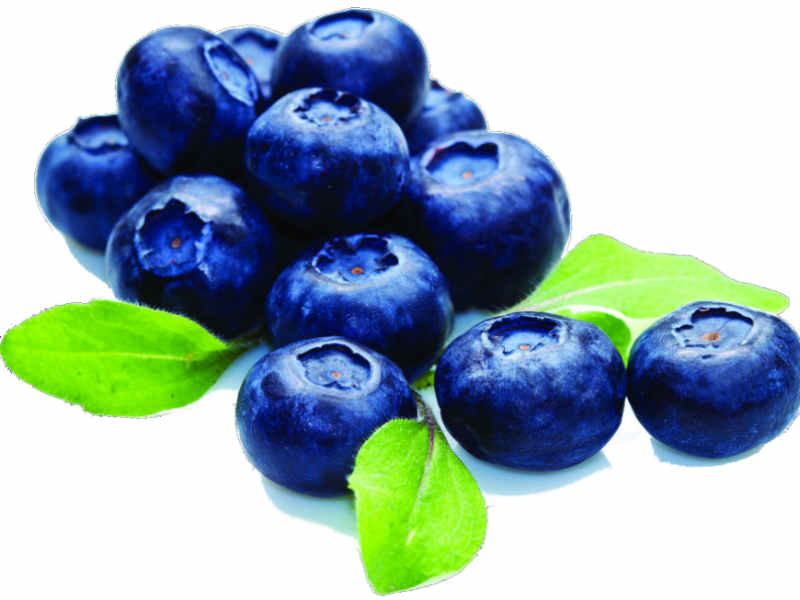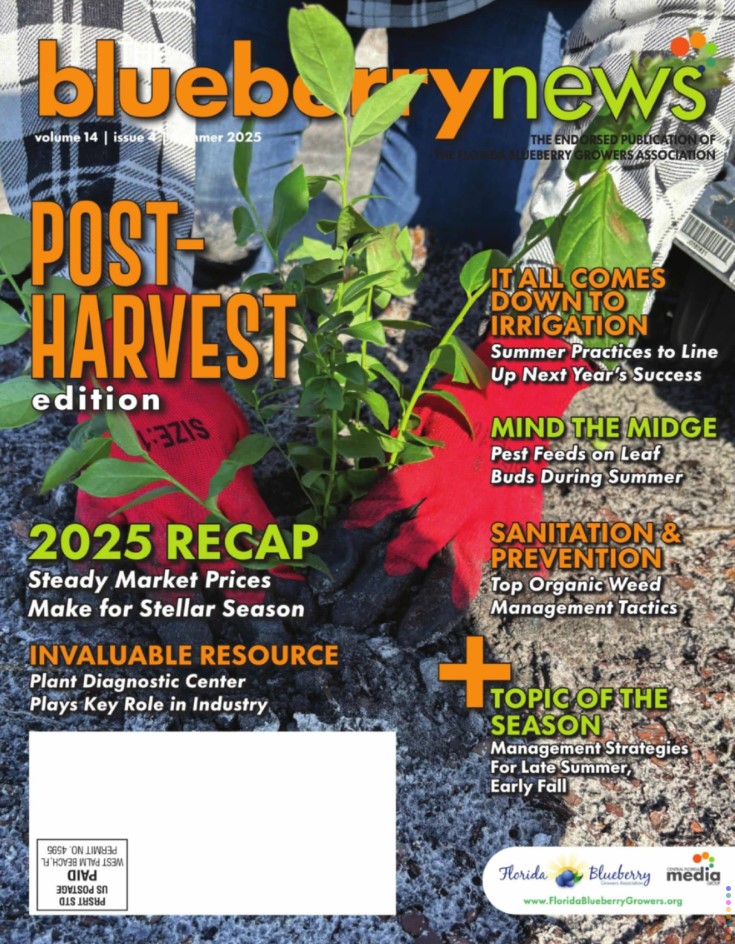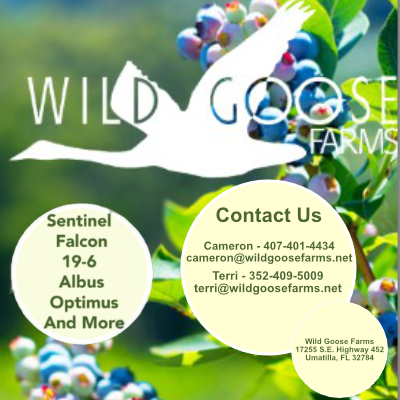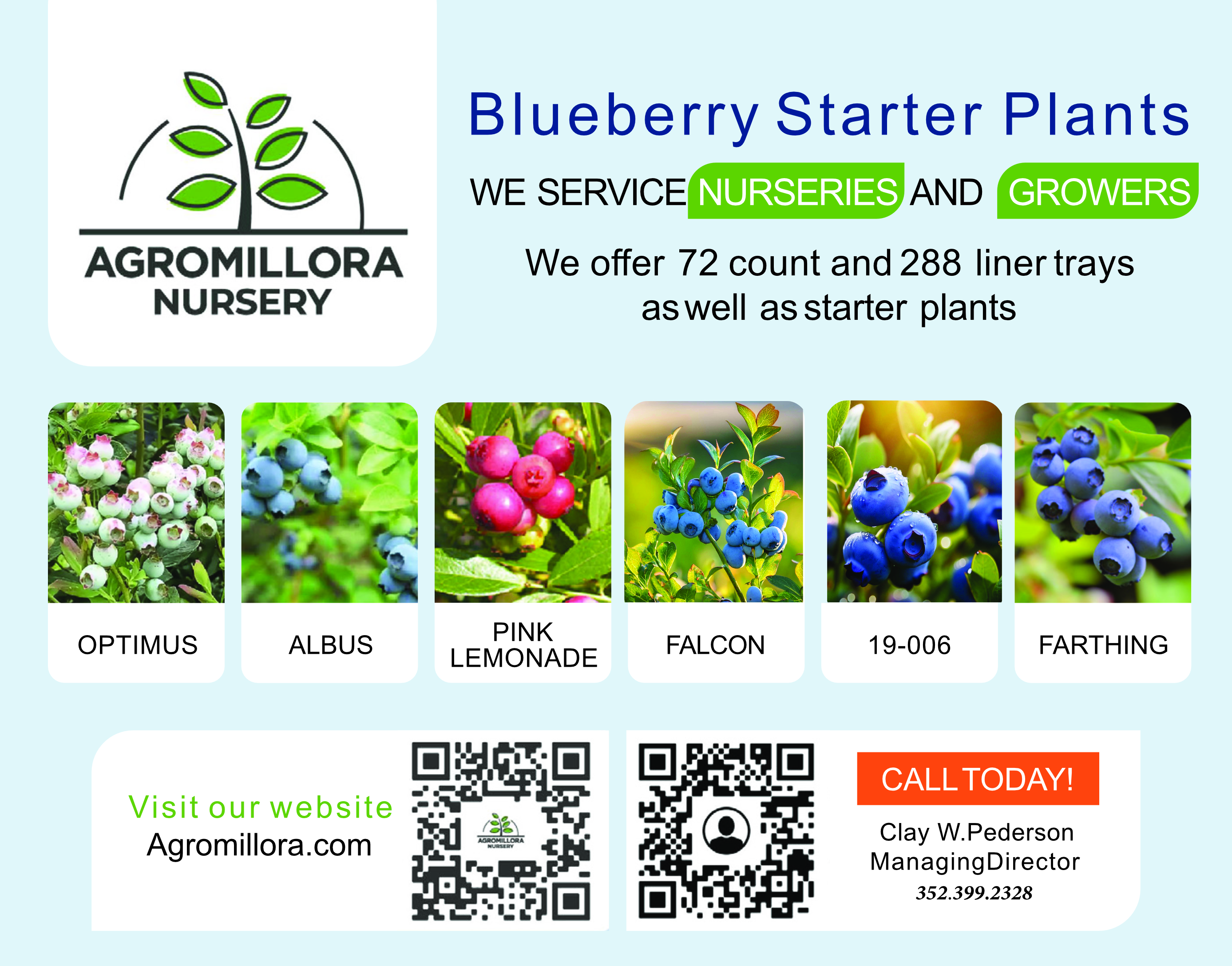A Team Effort to Assist Blueberry Stakeholders in Florida
by Dr. PATRICIO MUÑOZ
Florida producers are facing major challenges, with more countries producing and shipping blueberries into the US, higher volumes of fruit putting downward pressure on prices, and direct competition infringing on the historical Florida window. As a land grant university, the University of Florida’s mission is to help Florida growers, nurseries, marketers, retailers, and ultimately Florida blueberry consumers. This is accomplished through different departments within the Institute of Food and Agricultural Sciences (IFAS), and within many different research and extension programs.
The UF/IFAS blueberry breeding program has always supported Florida producers by developing new cultivars that can provide an edge to allow growers to better compete. Yield, timing of production, disease/pest resistance, fruit size, a drier and smaller scar, and better flavor are some of the traits we continue to improve through the breeding program. The following are projects that are currently underway, or will begin this coming 2019 season, in collaboration with several UF/IFAS experts:
A new webpage as a resource for all stakeholders to stay informed: Cultivar performance data will be uploaded annually at blueberrybreeding.com to help growers decide which cultivars to plant to maximize profits. This data includes cultivar yield, timing of production, number of weeks to produce 10%, 50%, and 90% of the crop, major notes about disease/pest susceptibility, and fruit quality characteristics.
Increase in the number of elite test selection sites across the state: Our network of elite selection field trials across the state was increased to ten sites, which gives us an increased probability of selecting improved cultivars that are stable across the state, or stable across productions systems.
Cultivar trials installed in central Florida: In 2018 fifteen southern highbush cultivars were established in two field trials in Balm, Florida, which will allow a side-by-side comparison of all currently available commercial varieties planted in the state. One trial will be managed as evergreen and the second as deciduous, allowing producers to observe and choose the best system for each cultivar. All commercially available cultivars are now planted in Balm and Citra to be used in demonstrations and field days.
Early stages of breeding selection duplicated in south Florida to better select for evergreen production: Early selections of elite material have historically been made in Waldo, Florida under a deciduous system using hydrogen cyanamide. Although this worked well, many of the materials selected did not perform as well in the central-south part of the state. Additionally, there has been an increase in the production area in central-south Florida. Therefore, in 2017 we moved the first set of early breeding materials to a south Florida site, and in 2019 the first set of elite selections under an evergreen system will be made.
These last three items have only been possible because of the hiring of Doug Phillips, who is the new central Florida blueberry specialist. Doug is providing great support to growers and researchers by facilitating day-to-day communication.
New production system to maximize profitability: Substrate production (i.e., soilless or container production) is trending globally. While this involves a higher investment, this intensive production system has shown to be promising in several respects, and thus could prove to be more profitable. Together with Dr. Gerardo Nuñez, we have established a large substrate experiment where we are testing different substrate mixes, pot sizes, and genetics. The results of this experiment will provide information for recommendations to growers, as well as information for the breeding program to select the best plant materials for this new system. Yang Fang, a PhD student in the blueberry breeding program, is the project lead.
Machine harvesting research: With increasing labor costs and decreasing labor availability, developing cultivars with good machine harvesting performance could significantly help Florida producers. Dr. Jeff Williamson and Dr. Steven Sargent, working together with Dr. Fumi Takeda, will be testing new harvesting machine models that are designed to handle fruit more gently, allowing for higher marketable yield and profits. We will be testing this equipment on elite trial selections that have high potential to become cultivars. The intent is to know when a cultivar will be a good fit for machine harvesting before it is released. We will intensify our efforts to identify high yielding cultivars with sufficient fruit firmness and concentrated fruit production for machine harvesting. Fruit firmness is probably the most important trait for new cultivars for use in machine harvesting. We are working to identify the genetic basis of fruit firmness so we can accelerate the process of selecting for this trait. This portion of the project is being conducted by PhD student David Friedman (in collaboration of Dr. Saba) and PhD student Francesco Cappai.
Better flavor and more blueberry consumption will benefit all stakeholders: Research studies have shown that flavor is one of the most important traits for consumers. With the collaboration of Dr. Thomas Colqhound, the project of PhD student Timothy Johnson is to find the genetic basis of several aromatic compounds that either increase or decrease likability of blueberry. PhD student Haley Sater is working on understanding the unique aromas detected in blueberry, and at what level consumers are able to detect these aromatic components. Post-doctoral associates Felipe Ferrao and Juliana Benevenuto are working to determine the location of the genes that control these traits, and which of these components could make the biggest difference in flavor, in order to focus on the selection of these traits in the breeding program. Finally, PhD student Lorenzo Bizzio is working toward the characterization of these genes, to improve genetic selection in the breeding program.
Accelerating the development of cultivars: The use of molecular markers to accelerate the process of selection in plant breeding has been proven in many species. However, the genetics of blueberry is more complex than that of many other plants. PhD student Rodrigo Amadeu and post-doctoral associate Ivone de Bem Oliveira are working on implementing these methods in the breeding program.
Wild species have been the basis of the Florida blueberry industry: In the past, the use of species of Vaccinium naturally occurring in the southeastern US made creation of the southern highbush blueberry possible. We are continuing to explore the variability of these species and incorporating traits that are lacking in cultivated species. This work is led by Dr. Paul Lyrene, MS student Diego Cabezas, and PhD student Austin Wenta.
Disease and pest screening of cultivars and new selections: In collaboration with Dr. Phil Harmon and Dr. Oscar Liburd, we are working to develop screening protocols for the most important diseases and pests. Norma Flor, a postdoctoral associate, is currently working in screening early selections and developing high throughput protocols for diseases, while PhD student Marice Lopez will be working to develop a reliable protocol for screening for gall midge susceptibility.
Understanding pollination to improve fruit set: Fruit set is one of the main components of yield, and pollination is a major factor in fruit set. Working in collaboration with Dr. Rachel Mallinger (and one of her PhD students beginning in 2019), we will be investigating the components of pollination with the goal of selecting traits that can improve fruit set.
Hydrogen cyanamide dosage: In collaboration with Dr. Jeff Williamson, we are conducting an experiment to determine the appropriate level of hydrogen cyanamide to be applied to recently released cultivars, as well as elite selections with high potential to become cultivars. In the future we expect to release this information along with the cultivar release. We are also bringing on board a new MS student to continue testing varieties and elite selections for their hydrogen cyanamide response.






